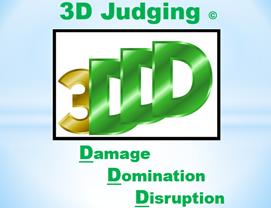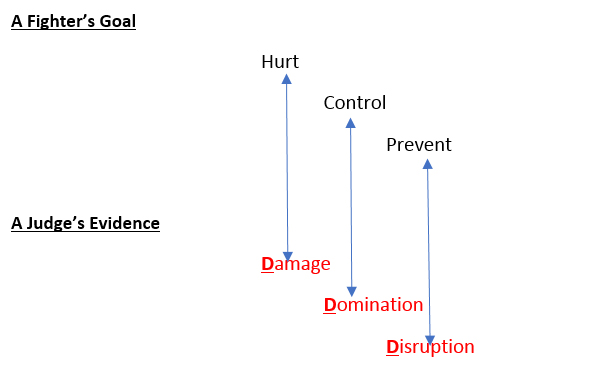
A New Perspective on Scoring Rounds for Current Ring Officials and Boxing Fans
It may sound unusual but the concept of 3D Judging© has its origin with the television show, “Dancing with the Stars.” For those of you who are not familiar with “Dancing with the Stars,” it is an American TV show in which professional dancers are paired with various celebrities in a dance competition that is evaluated by three trained dance judges. Since my wife likes to watch “Dancing with the Stars” that pretty much guarantees that I have to watch “Dancing with the Stars!” Over time, my wife would get frustrated because her scores of the various couples’ performances frequently differed from those of the professionally trained dance judges. That’s because my wife’s scores for the couples were based on such factors as who the celebrity was, what song they danced to, and what outfit they were wearing. Whereas the trained dance judges were evaluating the performances from a technical aspect according to the dance style that they were performing. To be quite honest, neither my wife nor I know the difference between a Samba, a Tango, a Waltz, or a Paso Doble. On the other hand, the judges on the show know exactly the technical requirements of each dance style. Their scores were based strictly on what the couples were trying to accomplish based on the specific dance that they were assigned to perform. That was the “light bulb” moment for me: how can you judge somebody or something if you don’t know what the specific goal that they’re trying to accomplish is? Thanks to “Dancing with the Stars,” I developed the 3D Judging© theory for boxing.
I began thinking about other sports that are evaluated by a panel of judges. Most of us watch sports like figure skating, gymnastics, and diving during the Olympics. But we watch these sports as spectators for the pure athleticism of the athletes and not as judges because like “Dancing with the Stars, we don’t know exactly what the athletes are trying to accomplish with their specific sports. When I think of diving, for example, I naively think a dive with a huge splash at the finish is “cool” when the exact opposite is true for Olympic diving scoring.
The same can be said for the sport of boxing. Most people (fans) watch boxing as spectators and some simply watch for the sport hoping to see a knockout. Professional boxing judges on the other hand do not and should not watch the sport as fans do. Fans watch fights; judges score rounds. Like the judges on “Dancing with the Stars” or Olympic judges for figure skating, gymnastics, and diving, we should judge the fighters based on what they are trying to accomplish when they enter the ring.
After much thought, I concluded that boxers are trying to do three things when they enter the ring. First and foremost, boxing is a combat sport. So naturally, a fighter is trying to hurt their opponent. However, some fighters are not gifted with the natural power to physically hurt their opponent like a Sonny Liston or a George Foreman or a Mike Tyson. Other fighters are more skilled in the subtle nuances of the sport like a Muhammad Ali or a Floyd Mayweather or a Pernell Whitaker. Fighters like these I would argue are trying to control their opponent in order to win. Lastly, I conclude that in addition to trying to hurt or control their opponent, a fighter is also naturally trying to prevent their opponent from hurting or controlling them.
My conclusions about what a boxer is trying to do when they fight led me to another realization. Boxing judges are just like judges in a courtroom where two opposing sides are competing to try and convince the judge that they deserve to win. So how do these opposing sides try to convince the courtroom judge? They do it with evidence of course. The same goes for boxing judges. As judges, we should be looking for evidence of what a fighter is trying to do with their opponent.

Now that I’ve introduced the theory behind the concept of 3D Judging©, it’s now time to provide some specific examples of what boxing actions constitute evidence of the 3D’s (Damage, Domination, Disruption). Let’s start with the most obvious and easiest for a boxing judge to identify.
Damage
Some examples of damage that a judge should look for as one fighter is trying to hurt their opponent are as follows:
- Knocking down your opponent
- Staggering your opponent
- Violently snapping back your opponent’s head
- Significant body blows that obviously slow down your opponent
Some examples of domination that a judge should look for as one fighter is trying to control their opponent are as follows:
Domination
- Distinct advantage in terms of punches landed
- Repeatedly initiates the action during an exchange
- Repeatedly lands the last punch during an exchange
Some examples of disruption that a judge should look for as one fighter is trying to prevent their opponent from hurting or controlling them are as follows:
Disruption
- Effective counter punching that alters your opponent’s strategy
- Punches that force your opponent to repeatedly grab & hold
- Punches that forces your opponent into a defensive posture
- Punches and movement that prevent or neutralize the progress of your opponent
Regardless of the reason that wide scoring variations sometimes occur, the 3D Judging© concept seeks to reduce these variances by clarifying and simplifying what judges should focus on when scoring rounds. By doing this, the hope is that when their scores are totaled at the end of a fight, we will begin to see more consistency and fewer variations in the scores.
This is the concept of 3D Judging© which was conceived specifically for ring officials but can be used by boxing fans as well. By developing a simpler process to better understand what boxing judges should be looking for when scoring rounds, the goal of reducing scoring variances by ring officials will be achieved.





More News
IBF Asia Heavyweight Title Fight: Bisutti vs. Nattapong
Liu Gang, Brico Santig Join Forces
Highland’s Double Impact: August 18 at Lumpinee